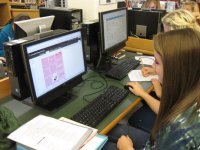Using E-Portfolios in the Classroom
For decades, students have been completing assignments in school. Often, these were seen only by the teacher, graded and returned to the student. Sometimes, the work was posted on a classroom wall or in a school hallway. Many teachers kept portfolios of student work for report card conferences, and the rare teacher taught students how to build their own portfolios from their work.
With more and more schools going paperless or migrating to the "cloud" (storing files on the Internet), student work has become more easily shareable, accessible by many, and more easily organized. Many teachers have turned to digital portfolios -- or "e-portfolios" -- for their students. These digital portfolios have caused a huge shift in how teachers assign, collect and assess student classwork and projects.
However, with so many options for collecting and sharing student work, it's hard to know which method or tool to use.
Defining Your Needs
Here are some guiding questions to consider before you commit to a tool or platform:
- Can student work be made public or is it housed inside a "walled garden?"
- Can students view and comment on each other's work?
- Can the teacher provide feedback for the student privately?
- Is student work easily organized by date, course or some other category?
- Are the portfolios transferable from year to year as students move through the school?
- Can students access their work or export it when they leave the school?
- Does the platform allow for multiple file types (documents, sound files, video files)?
- What are the costs for using the tool or platform?
- Can a teacher create a teacher account and student accounts, or do students sign up on their own? Is there a minimum age to sign up?
- Can the tool be integrated into an existing SMS or other school-wide database and/or gradebook?
While some of these questions may not apply to your situation, it is important to do your research before committing to a tool. Once your students begin building their portfolio, it can be time-consuming and often frustrating to transfer student work to another platform.
Some Options
Below is a list of tools that can be used to collect, organize and share student work. Those that are free are marked with an asterisk (*).
This tool organizes, tracks and shares learning in a project-based learning classroom. It includes standards-based grading tools and feedback tools. Teachers have the option to include a digital portfolio website for students.
Create a website to share classwork and projects. Potential users must be at least 13 to sign up. Students can use the "file locker" option to upload files.
Wikispaces and PBwiki*
These two wiki-creation tools allow students to create a website of their work. Due to the collaborative nature of the tools, student teams can build a workspace to showcase their work. The teacher can create student accounts without an email address. (Note: PBwiki is also known as PBworks.)
Students can create a public folder in Dropbox to share their work. This platform supports multiple file types and can be used collaboratively by sharing folders.
Students can create "notebook" within their Evernote account for each class, and that notebook can be shared publicly. Students can upload files to their notebooks, including documents, photos and audio files.
eBackpack
Teachers can assign, collect, grade and return assignments to students through eBackpack. Students can upload files to their digital locker to create an online portfolio for their course. Work uploaded cannot be seen outside of the closed system.
